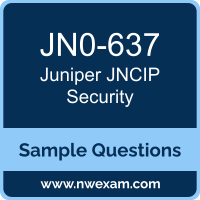01. Which two statements are true about ADVPN members?
(Choose two.)
a) ADVPN members are authenticated using certificates.
b) ADVPN members are authenticated using pre-shared keys.
c) ADVPN members can use IKEv2.
d) ADVPN members can use IKEv1.
02. You are deploying a virtualization solution with the security devices in your network Each SRX Series device must support at least 100 virtualized instances and each virtualized instance must have its own discrete administrative domain.
In this scenario, which solution would you choose?
a) VRF instances
b) virtual router instances
c) logical systems
d) tenant systems
03. How does secure wire mode differ from transparent mode?
a) In secure wire mode, traffic can be modified using source NAT.
b) In secure wire mode, no switching lookup takes place to forward traffic.
c) In secure wire mode, security policies cannot be used to secure intra-VLAN traffic.
d) In secure wire mode, IRB interfaces can be configured to route inter-VLAN traffic.
04. In an effort to reduce client-server latency transparent mode was enabled an SRX series device. Which two types of traffic will be permitted in this scenario?
(Choose Two.)
a) ARP
b) Layer 2 non-IP multicast
c) BGP
d) IPsec
05. All interfaces involved in transparent mode are configured with which protocol family?
a) ethernet - switching
b) inet
c) bridge
d) mpls
06. What is a function of UTM?
a) content filtering
b) AppFW
c) IPsec
d) bridge mode
07. You want to use selective stateless packet-based forwarding based on the source address. In this scenario, which command will allow traffic to bypass the SRX Series device flow daemon?
a) set firewall family inet filter bypas3_flowd term t1 then virtual-channel stateless
b) set firewall family inet filter bypaa3_flowd term t1 then skip-services accept
c) set firewall family inet filter bypass__f lowd term t1 then packet-mode
d) set firewall family inet filter bypass_flowd term t1 then routing-instance stateless
08. Which two additional configuration actions are necessary for the third-party feed shown in the exhibit to work properly?
(Choose two.)
a) You must create a dynamic address entry with the IP filter category and the ipfilter_office365 value.
b) You must apply the dynamic address entry in a security policy.
c) You must apply the dynamic address entry in a security intelligence policy.
d) You must create a dynamic address entry with the C&C category and the cc_offic365 value.
09. Which Junos security feature is used for signature-based attack prevention?
a) RADIUS
b) AppQoS
c) IPS
d) PIM
10. After downloading the new IPS attack database, the installation of the new database fails. What caused this condition?
a) The new attack database no longer contained an attack entry that was in use.
b) The new attack database was too large for the device on which it was being installed.
c) The new attack database was revoked between the time it was downloaded and installed.
d) Some of the new attack entries were already in use and had to be deactivated before installation.
 Before you write the Juniper JNCIP Security (JN0-637) certification exam, you may have certain doubts in your mind regarding the pattern of the test, the types of questions asked in it, the difficulty level of the questions and time required to complete the questions. These Juniper Networks Certified Professional Security (JNCIP-SEC) sample questions and demo exam help you in removing these doubts and prepare you to take the test.
Before you write the Juniper JNCIP Security (JN0-637) certification exam, you may have certain doubts in your mind regarding the pattern of the test, the types of questions asked in it, the difficulty level of the questions and time required to complete the questions. These Juniper Networks Certified Professional Security (JNCIP-SEC) sample questions and demo exam help you in removing these doubts and prepare you to take the test.